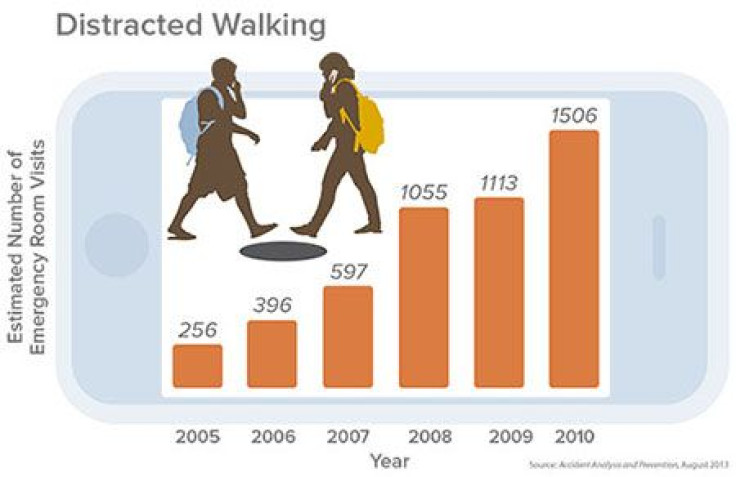Distracted Walking Injuries While On The Phone More Than Doubled Since 2004; Could Be Twice As High By 2015

When people talk about 21st-century problems, they talk about global warming, water shortages, or forgetting a charger in their hotel room. New research from The Ohio State University reveals another problem deserves attention: pedestrians getting distracted while on the phone and sustaining "distracted walking" injuries.
The figures, while tiny, show startling growth potential. Professor of city and regional planning at OSU and the study's co-author, Jack Nasar found the number of injuries pedestrians sustained while talking on the phone more than doubled from 2004, at 559 cases, to 1,506 in 2010.
The statistics regarding distracted driving still dominate over distracted walking, with 387,000 injuries resulting from distracted drivers in 2011, according to the Centers for Disease Control and Prevention (CDC) That number is down, in fact, from 416,000 in 2010. Meanwhile, distracted walking injuries related to cell phone use continue to multiply year after year.
"The role of cell phones in distracted driving injuries and deaths gets a lot of attention and rightly so," Nasar remarked. "But we need to also consider the danger cell phone use poses to pedestrians."
Not all age brackets represented the data equally. Perhaps unsurprisingly, the 21-25 demographic comprised the largest chunk of the injuries, with 1,003 total injuries over the course of the seven-year study. Sixteen- to 20-year-olds came in second with 985 total injuries.
Nasar and his co-researcher, former graduate student at OSU, Derek Troyer, used data from the National Electronic Injury Surveillance System, a database maintained by the U.S. Consumer Products Safety Commission (CPSC). The data consisted of injury samples collected from 100 hospitals across the country. These samples were then extrapolated to estimate the total number of injuries emergency rooms see each year.
The study collected data from 2004-2010 and focused primarily on the injuries related to cell phones. These included talking on the phone, texting, playing games, and other related activities.
From 2004-2010 the total number of distracted walking injuries more than halved, from 97,000 to 41,000.
The researchers find these statistics rather sobering. Smart phones proliferated wildly in the seven years Nasar and Troyer performed the study. The rise of social media likely plays a large role in incentivizing younger generations to use their phone in public more frequently.
And to that frequency, Nasar and Troyer argue the data significantly underestimates the actual number of injuries each year. The team compared distracted driving injuries reported by the CPSC to emergency room reports as a barometer for distracted walking, as walking injuries currently do not have data to make the same comparison.
Research examining increases in traffic accidents related to cell phone use suggests that the number of crash-related injuries in emergency rooms is actually about 1,300 times higher than CPSC national estimates, Nasar said.
He and his co-researcher believe a more accurate count of cell phone-related injuries "might" come from the same relationship, which, if verified, would put the 2010 injury statistics at two million injuries related to cell phones.
Nasar added that the embarrassment of a cell phone injury could lead people to underreport the actual cause of their emergency room visit.
"It is impossible to say whether 2 million distracted pedestrians are really injured each year," Nasar said. "But I think it is safe to say that the numbers we have are much lower than what is really happening."
For pedestrians, talking on the phone accounted for about 69 percent of injuries, compared to texting, which accounted for about nine percent.
The researchers believe parent involvement is the easiest way to prevent the explosion from swelling any further.
"As more people get cell phones and spend more time using them, the number of injuries is likely to increase as well. Now people are playing games and using social media on their phones too," he said. "Parents already teach their children to look both ways when crossing the street. They should also teach them to put away their cell phone when walking, particularly when crossing a street."
Nasar and Troyer's study will appear in the August 2013 issue of the journal Accident Analysis and Prevention.



























